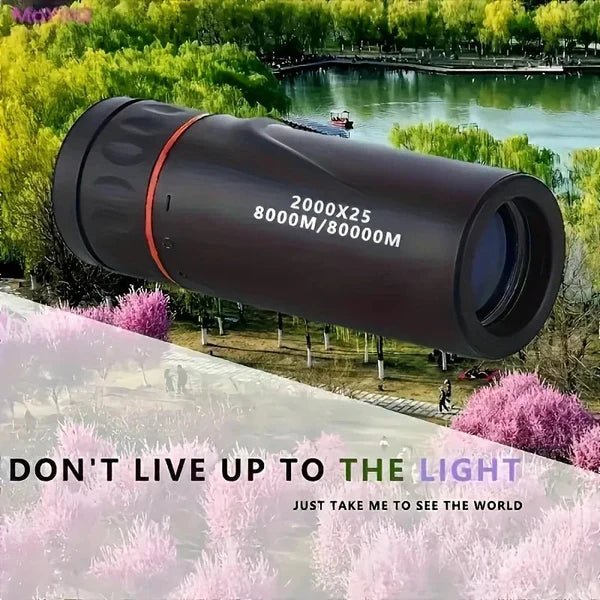
Explore More with Less – Why a Monocular Telescope Is a Must-Have for Nature Lovers
Share
Introduction
Whether you're scaling a mountain trail or simply strolling through a forest, the natural world is full of beauty waiting to be discovered—if you can see it clearly. For hikers, birdwatchers, campers, or curious wanderers, a monocular telescope offers the perfect blend of power, portability, and convenience.
Forget the bulkiness of traditional binoculars. The compact monocular telescope is your new go-to gadget for zooming in on nature’s most awe-inspiring moments.
What Is a Monocular Telescope?
A monocular telescope is essentially a small, lightweight, one-eye version of binoculars. It uses lenses and sometimes prisms to magnify distant objects, making it ideal for spotting wildlife, landmarks, or even the night sky.
Its compact size means you can slip it into your pocket or daypack, making it perfect for minimalist travelers and adventurers.
Why Monoculars Beat Binoculars for Many Users
- Lighter and more compact – easier to carry
- One-eye use – better for quick viewing
- Ideal for single-handed operation
- Great for eyeglass wearers
- Often more affordable with comparable clarity
Whether you're tracking a bird in flight or scanning the horizon on a camping trip, a monocular makes it easy to zoom in instantly without adjusting two lenses.
Top Features to Look For
If you’re shopping for a monocular telescope, look for:
- High magnification (8x – 12x)
- Wide field of view
- Multilayered lens coating for clarity
- Waterproof or fog-resistant construction
- Rubberized grip for outdoor use
- Smartphone adapter for quick snapshots
The right features will make the difference between a good view and a jaw-dropping close-up experience.
Ideal Use Cases
1. Hiking & Trekking
Spot trail markers, mountain goats, distant waterfalls, or scenic lookouts—all without veering off the path.
2. Birdwatching
Track birds mid-flight or perched in trees with powerful zoom and a clear field of view.
3. Stargazing
Point toward the night sky and get a better look at the moon or constellations.
4. Travel Photography
Use with your smartphone to capture zoomed-in photos of wildlife or architectural details.
5. Sporting Events or Concerts
Enjoy a front-row experience from the back of the crowd with incredible close-ups.
Real User Reviews
“It’s amazing how much detail I can see on a bird’s feathers even from 100 feet away. I never hike without it.” – Jake P., Lake District
“Super lightweight and easy to pack—I used it in Kenya and it made our safari so much more exciting.” – Rachel T., London
How to Use a Monocular Telescope Effectively
- Adjust the eyecup for comfort, especially if you wear glasses.
- Use two hands for stability or mount it on a small tripod.
- Scan slowly from one side to another to find your subject.
- Use your phone adapter (if available) to snap long-distance photos.
- Clean your lens regularly to avoid blurriness.
FAQs
Q1: Can I use it at night?
Yes, especially under moonlight or with low-light lenses. It’s not night vision, but works well at dusk or dawn.
Q2: Is it waterproof?
Most models offer water resistance. Check the specs for full waterproof ratings.
Q3: Can kids use it?
Absolutely. Many monoculars are light and easy to handle for young explorers.
Q4: How is it different from a spotting scope?
Spotting scopes are larger and mounted on tripods—great for serious wildlife observation. Monoculars are for quick, handheld use.
Final Thoughts
From nature walks to world travel, a monocular telescope is your ticket to seeing more, experiencing more, and capturing it all in sharp detail. Compact, powerful, and ready for adventure, it’s the must-have gear your backpack has been missing.
👉 Discover what you’ve been missing—shop our monocular telescope today at CheckoutsUK.com
